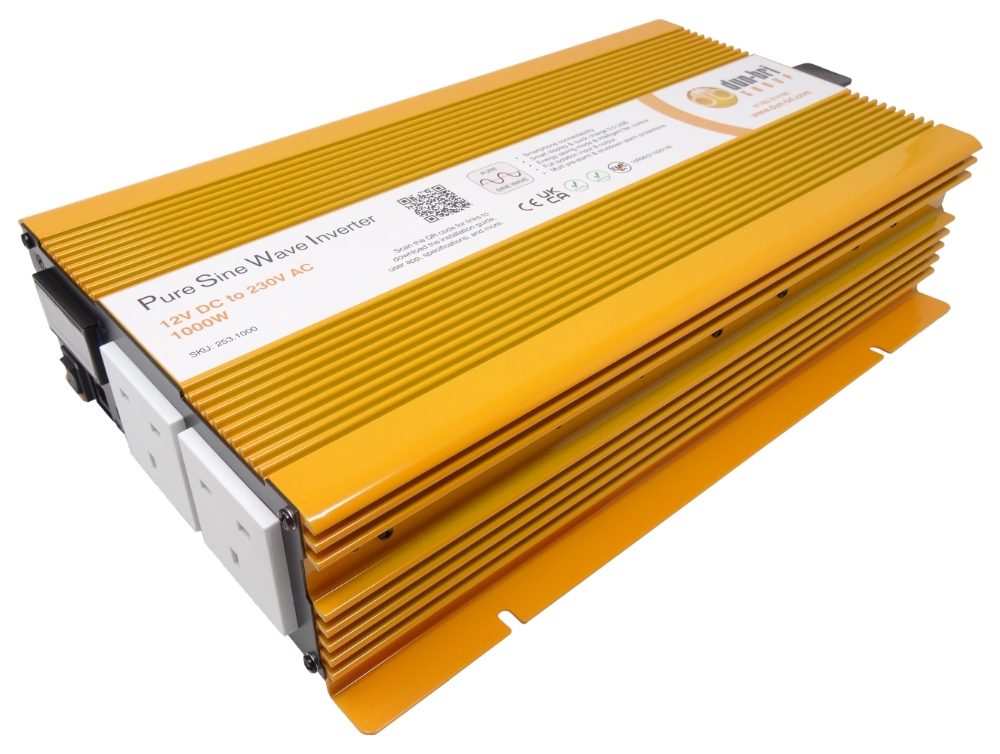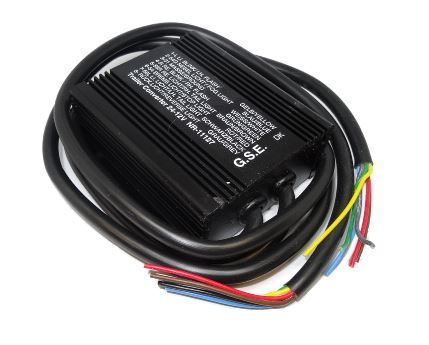05 January 2024
Table of Contents:
- Introduction
- What is a Vehicle Power Inverter?
- What is a Vehicle Power Converter?
- Key Differences Between Power Inverters and Converters
- Choosing the Right Device for Your Vehicle
- Conclusion
In the dynamic world of commercial and emergency vehicles, efficient power management plays a crucial role in ensuring that operations run smoothly and effectively. Whether it's powering essential tools for a roadside repair or ensuring that emergency equipment is operational at all times, the right power solutions are vital. Among these solutions, vehicle power inverters and converters stand out as key components, yet they are often confused or misunderstood.
In this post, we aim to demystify these two critical devices, breaking down their functions, uses, and the benefits they offer. By understanding the differences between a vehicle power inverter and a power converter, trade professionals can make informed decisions about the best power management solutions for their specific needs. Whether you are outfitting a fleet of commercial vehicles or ensuring that an emergency vehicle is equipped with the right tools, knowing these differences is essential. Join us as we explore the unique roles and advantages of vehicle power inverters and converters in the auto-electrical industry.
Key Takeaways
| Section |
Key Points |
| Intro |
Importance of understanding power inverters and converters in vehicle power management. |
|
| What is a Vehicle Power Inverter? |
Converts DC to AC. Used for standard AC devices in vehicles. Offers flexibility, efficiency, and safety. |
|
| What is a Vehicle Power Converter? |
Changes one level of DC voltage to another. Essential for devices with different voltage needs. Provides compatibility, stability, and safety. |
|
| Differences Between Inverters and Converters |
Inverters convert DC to AC; converters modify DC voltage levels. Different applications based on power requirements of devices. |
|
| Choosing the Right Device |
Consider power requirements, vehicle compatibility, and additional features. Seek expert advice for best fit. |
|
| Conclusion |
Understanding and choosing the right power solution is crucial for vehicle efficiency and functionality. Dun-Bri Group offers expert guidance and solutions. |

At its core, a vehicle power inverter is a device that serves a critical role in the electrical systems of modern vehicles, especially in commercial and emergency contexts. But what exactly is it, and how does it function?
Definition and Basic Function:
- A vehicle power inverter is designed to convert direct current (DC), typically from a vehicle's battery, into alternating current (AC). This conversion is crucial because most of the everyday tools and devices we use, from laptops to power tools, operate on AC power.
- Inverters come in various capacities, ensuring that they can handle the power demands of different devices, from small chargers to larger electrical equipment.
Common Uses in Commercial and Emergency Vehicles:
- In commercial vehicles, inverters are often used to power laptops, charge power tool batteries, or run small appliances for mobile offices.
- In emergency vehicles, inverters play a vital role in powering critical equipment, such as communication devices and medical equipment, that require reliable AC power.
Advantages of Using Power Inverters:
- Flexibility: Power inverters allow the use of standard AC devices in a vehicle, providing flexibility and convenience for professionals on the move.
- Efficiency: Modern inverters are designed to be highly efficient, minimizing energy loss during the conversion process and ensuring that devices can be used effectively for longer periods.
- Safety: Quality inverters include safety features like overload protection, short-circuit protection, and thermal shutdown to protect both the vehicle's electrical system and the connected devices.
By understanding the role and benefits of vehicle power inverters, trade professionals can effectively equip their vehicles to meet the demands of their work, ensuring that they have access to the power they need, whenever and wherever they need it.

While inverters are essential for converting DC to AC, another vital component in vehicle electrical systems is the power converter. This device plays a different yet equally important role.
Definition and Basic Function:
- A vehicle power converter is designed to modify the voltage level of a vehicle's DC electrical supply. Unlike inverters, converters deal exclusively with DC power, typically stepping down a higher DC voltage (like 24V) to a lower one (like 12V). This is particularly crucial in vehicles that need to support equipment designed for different voltage levels.
- Converters are available in various capacities and configurations, accommodating the diverse needs of different vehicle systems and devices.
Typical Applications in Vehicles:
- In commercial vehicles, power converters are often used when installing equipment that operates at a different voltage than the vehicle's standard electrical system. This includes specialized lighting, audio-visual equipment, or diagnostic tools.
- For emergency vehicles, converters ensure that all on-board equipment operates reliably and safely, regardless of the native voltage requirements. This includes communication systems, emergency lighting, and other critical tools.
Benefits of Using Power Converters for Trade Customers:
- Compatibility: Power converters enable the use of a wide range of devices and accessories in a vehicle, regardless of their original voltage requirements.
- Stability: They provide a stable and reliable power supply, which is essential for the proper functioning of sensitive electronic equipment.
- Safety: Like inverters, quality power converters come with safety features to protect against overvoltage, under voltage, and thermal overload, ensuring the safety of both the vehicle and its electronic components.
Understanding the function and advantages of vehicle power converters is essential for trade professionals looking to enhance the versatility and capability of their commercial or emergency vehicles. With the right power converter, a vehicle can safely and efficiently operate a broader range of equipment, making it a multifunctional asset in any trade.
Understanding the differences between power inverters and converters is crucial for making informed decisions about vehicle power systems. Here, we'll delve into their distinct characteristics and applications.
Voltage Conversion:
- Power Inverters: These devices convert DC (Direct Current) power from a vehicle’s battery into AC (Alternating Current) power. This is essential for operating standard AC appliances and tools in a vehicle.
- Power Converters: Conversely, power converters change one level of DC voltage to another (e.g., from 24V DC to 12V DC). They are used to adapt a vehicle’s electrical system to the voltage requirements of different DC devices.
Applications in Vehicle Settings:
- Inverters are ideal when there is a need to use standard household AC devices in a vehicle, such as charging laptops or running power tools that require AC input.
- Converters are used when there is a need to power or charge devices that require a different DC voltage than what the vehicle's electrical system provides. They ensure compatibility and safe operation of these devices.
Technical Specifications:
- Power inverters often come with features like modified sine wave or pure sine wave output, indicating the quality and type of AC power they produce, which is important for the proper functioning of sensitive electronic equipment.
- Power converters, on the other hand, may offer features like regulated output voltage to ensure a stable DC supply, and protection mechanisms against overcurrent, short-circuiting, and overheating.
By clearly distinguishing between these two types of devices, trade professionals can better assess their vehicle power needs and select the appropriate equipment for their specific applications. Whether it's a power inverter to convert DC to AC for regular appliances or a power converter to ensure stable DC voltage for vehicle-specific equipment, understanding these differences is key to optimizing the functionality and efficiency of commercial and emergency vehicles.
| Factor to Consider |
Inverter |
Converter |
| Type of Power Required |
Converts DC to AC for standard AC appliances and tools. |
Converts one level of DC voltage to another, usually stepping down to a lower voltage. |
|
| Power Capacity |
Ensure it can handle the total power load of all devices used simultaneously. |
Check that the converter can support the power requirements of your specific devices. |
|
| Vehicle Compatibility |
Must match the vehicle's electrical system in terms of voltage and current specifications. |
Ensure compatibility with the vehicle's electrical system, particularly voltage levels. |
|
| Installation Requirements |
May require professional installation for high-power applications. |
Installation needs to be compatible with the vehicle’s system, sometimes needing expertise. |
|
| Additional Features |
Look for pure sine wave output, efficiency ratings. |
Seek stable voltage output, safety features like overvoltage protection. |
|
| Expert Consultation |
Advisable for choosing the right inverter based on specific needs. |
Important for ensuring that the converter fits the vehicle’s and devices’ requirements. |
Selecting the appropriate power inverter or converter is not just about understanding their differences; it's about matching the right device to your specific needs. This section provides practical advice for trade professionals on how to choose between a power inverter and a converter for their commercial or emergency vehicles.
Assessing Your Power Requirements:
- Determine the type of devices you need to power: Do they require AC or DC power? Understanding the power needs of your equipment is the first step in choosing between an inverter and a converter.
- Consider the power capacity: Ensure that the inverter or converter you select can handle the total power load of all the devices you plan to use simultaneously.
Compatibility with Vehicle’s Electrical System:
- Verify the compatibility of the inverter or converter with your vehicle's electrical system. This includes checking the voltage and current specifications to ensure safe and efficient operation.
- Installation requirements: Some devices may require professional installation, especially for high-power applications. Consider the installation process and whether additional equipment (like wiring or fuses) is needed.
Additional Features to Look For:
- For inverters, look for features like pure sine wave output for sensitive electronic equipment, and efficiency ratings to minimize power loss.
- For converters, seek out models with stable voltage output and safety features like overvoltage protection to safeguard your vehicle's electrical system and the connected devices.
Consulting with Experts:
- When in doubt, it’s always advisable to consult with experts. Companies like Dun-Bri Group offer professional advice and can guide you in selecting the right power solution for your vehicle, taking into consideration your specific requirements and industry standards.
In the intricate world of vehicle power management, understanding the differences between power inverters and converters is not just a matter of technical know-how, but a necessity for ensuring efficiency and functionality in commercial and emergency vehicles. Through this post, we've explored the unique roles, applications, and benefits of each device, shedding light on their distinct features and importance in the auto-electrical industry.
Power inverters and converters are more than just accessories; they are critical components that enhance the versatility and capability of a vehicle, empowering trade professionals to perform their best work, regardless of their location. By making informed decisions about these power solutions, professionals in the auto-electrical trade can equip their vehicles to meet diverse and demanding power needs, ensuring readiness and reliability in every task.
Remember, the right power solution can make a significant difference in the efficiency and success of your operations. We encourage you to consider the insights shared in this post as you equip your commercial or emergency vehicles with the appropriate power inverter or converter. And for expert advice and high-quality vehicle power solutions, don't hesitate to reach out to us at Dun-Bri Group. We're here to help you power your business to the next level.